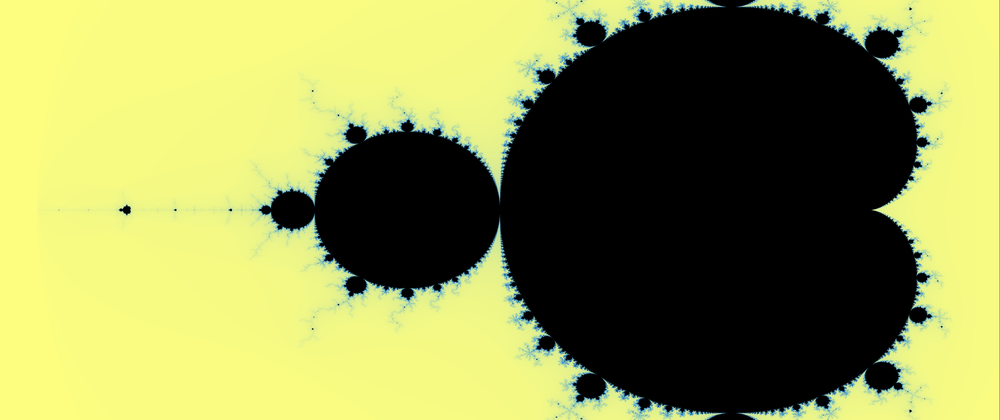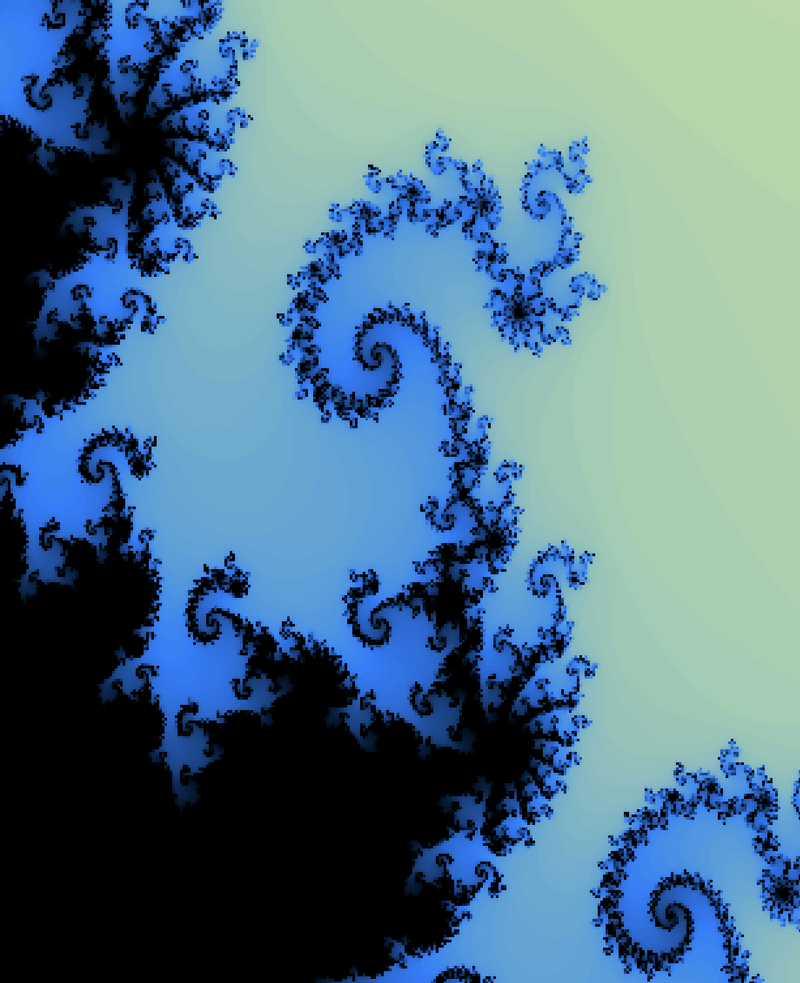We run embedded Zig code with Elixir. This is made possible with the library Zigler.
The main point is that we let Zig produce binary data that Elixir can consume easily and display when you use a Livebook (the Jupyter equivalent in Elixir).
As a showcase, we compute the Mandelbrot set.
The algorithm
Input data:
- image dimensions (eg W x H of 1500 x 1000),
- max iteration (eg 300)
We allocate a slice of W x H x 3 u8 and loop over it:
- Iterate over each pixel (i,j):
- map it into the 2D plane: compute its "complex coordinates"
- compute the iteration number
- compute a colour
- append the current slice
- Sum-up and draw from the final tensor with
Kino(Elixir library .
To speed-up, we use OS threads.
Elixir code
If you happen to have Livebook installed, pass this code.
We start by installing the three packages, define a module that compiles the Zig code once for all and provide a link between Zig and the BEAM (the VM that runs the Elixir code) for memory allocation and passing and receiving data.
Mix.install(
[{:kino, "~> 0.14.2"},{:zigler, "~> 0.13.3"}, {:nx, "~> 0.9.1"}],
)
defmodule Zigit do
use Zig, otp_app: :zigler,
nifs: [..., generate_mandelbrot: [:threaded]],
release_mode: :fast,
zig_code_path: "mandel.zig"
end
h = w = 1_000
max_iter = 300;
Zigit.generate_mandelbrot(h, w, max_iter)
|> Nx.from_binary(:u8)
|> Nx.reshape({h, w, 3})
|> Kino.Image.new
The Zig code returns a binary that we are able to consume with the Elixir library Nx and display the image with the library Kino.
To draw an image of 1.5M pixels, it takes a few milliseconds. Feels like magic.
The Zig code
The Elixir code runs on a VM, called the BEAM that provides an allocator for Zig
// mandel.zig
const beam = @import("beam");
const std = @import("std");
const Cx = std.math.Complex(f64);
const print = std.debug.print;
const topLeft = Cx{ .re = -2.1, .im = 1.2 };
const bottomRight = Cx{ .re = 0.6, .im = -1.2 };
const w = bottomRight.re - topLeft.re;
const h = bottomRight.im - topLeft.im;
const Context = struct { res_x: usize, res_y: usize, imax: usize };
/// nif: generate_mandelbrot/3 Threaded
pub fn generate_mandelbrot(res_x: usize, res_y: usize, imax: usize) !beam.term {
const pixels = try beam.allocator.alloc(u8, res_x * res_y * 3);
defer beam.allocator.free(pixels);
// threaded version
const resolution = Context{ .res_x = res_x, .res_y = res_y, .imax = imax };
const res = try createBands(pixels, resolution);
return beam.make(res, .{ .as = .binary });
}
// <--- threaded version
fn createBands(pixels: []u8, ctx: Context) ![]u8 {
const cpus = try std.Thread.getCpuCount();
var threads = try beam.allocator.alloc(std.Thread, cpus);
defer beam.allocator.free(threads);
// half of the total rows
const rows_to_process = ctx.res_y / 2 + ctx.res_y % 2;
// one band is one count of cpus
// const nb_rows_per_band = rows_to_process / cpus + rows_to_process % cpus;
const rows_per_band = (rows_to_process + cpus - 1) / cpus;
for (0..cpus) |cpu_count| {
const start_row = cpu_count * rows_per_band;
// Stop if there are no rows to process
if (start_row >= rows_to_process) break;
const end_row = @min(start_row + rows_per_band, rows_to_process);
const args = .{ ctx, pixels, start_row, end_row };
threads[cpu_count] = try std.Thread.spawn(.{}, processRows, args);
}
for (threads[0..cpus]) |thread| {
thread.join();
}
return pixels;
}
fn processRows(ctx: Context, pixels: []u8, start_row: usize, end_row: usize) void {
for (start_row..end_row) |current_row| {
processRow(ctx, pixels, current_row);
}
}
fn processRow(ctx: Context, pixels: []u8, row_id: usize) void {
// Calculate the symmetric row
const sym_row_id = ctx.res_y - 1 - row_id;
if (row_id <= sym_row_id) {
// loop over columns
for (0..ctx.res_x) |col_id| {
const c = mapPixel(.{ @as(usize, @intCast(row_id)), @as(usize, @intCast(col_id)) }, ctx);
const iter = iterationNumber(c, ctx.imax);
const colour = createRgb(iter, ctx.imax);
const p_idx = (row_id * ctx.res_x + col_id) * 3;
pixels[p_idx + 0] = colour[0];
pixels[p_idx + 1] = colour[1];
pixels[p_idx + 2] = colour[2];
// Process the symmetric row (if it's different from current row)
if (row_id != sym_row_id) {
const sym_p_idx = (sym_row_id * ctx.res_x + col_id) * 3;
pixels[sym_p_idx + 0] = colour[0];
pixels[sym_p_idx + 1] = colour[1];
pixels[sym_p_idx + 2] = colour[2];
}
}
}
}
fn mapPixel(pixel: [2]usize, ctx: Context) Cx {
const px_width = ctx.res_x - 1;
const px_height = ctx.res_y - 1;
const scale_x = w / @as(f64, @floatFromInt(px_width));
const scale_y = h / @as(f64, @floatFromInt(px_height));
const re = topLeft.re + scale_x * @as(f64, @floatFromInt(pixel[1]));
const im = topLeft.im + scale_y * @as(f64, @floatFromInt(pixel[0]));
return Cx{ .re = re, .im = im };
}
fn iterationNumber(c: Cx, imax: usize) ?usize {
if (c.re > 0.6 or c.re < -2.1) return null;
if (c.im > 1.2 or c.im < -1.2) return null;
// first cardiod
if ((c.re + 1) * (c.re + 1) + c.im * c.im < 0.0625) return null;
var z = Cx{ .re = 0.0, .im = 0.0 };
for (0..imax) |j| {
if (sqnorm(z) > 4) return j;
z = Cx.mul(z, z).add(c);
}
return null;
}
fn sqnorm(z: Cx) f64 {
return z.re * z.re + z.im * z.im;
}
fn createRgb(iter: ?usize, imax: usize) [3]u8 {
// If it didn't escape, return black
if (iter == null) return [_]u8{ 0, 0, 0 };
// Normalize time to [0,1] now that we know it escaped
const normalized = @as(f64, @floatFromInt(iter.?)) / @as(f64, @floatFromInt(imax));
if (normalized < 0.5) {
const scaled = normalized * 2;
return [_]u8{ @as(u8, @intFromFloat(255.0 * (1.0 - scaled))), @as(u8, @intFromFloat(255.0 * (1.0 - scaled / 2))), @as(u8, @intFromFloat(127 + 128 * scaled)) };
} else {
const scaled = (normalized - 0.5) * 2.0;
return [_]u8{ 0, @as(u8, @intFromFloat(127 * (1 - scaled))), @as(u8, @intFromFloat(255.0 * (1.0 - scaled))) };
}
}








Latest comments (0)